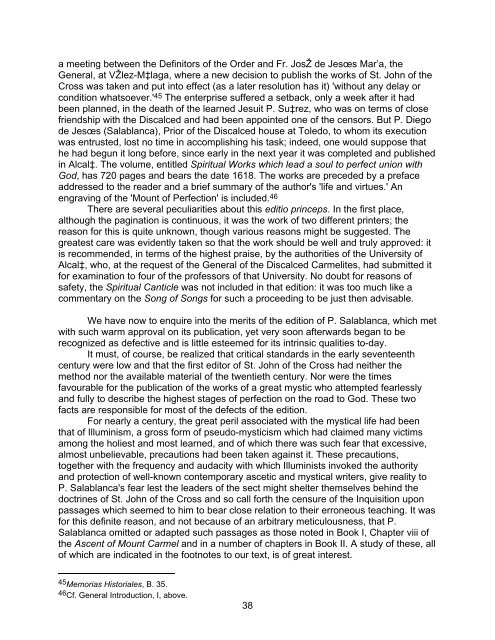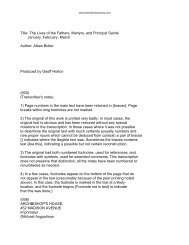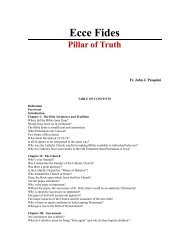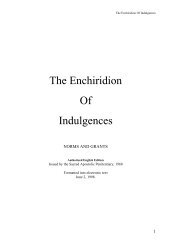Ascent of Mt. Carmel - St. Patrick's Basilica
Ascent of Mt. Carmel - St. Patrick's Basilica
Ascent of Mt. Carmel - St. Patrick's Basilica
Create successful ePaper yourself
Turn your PDF publications into a flip-book with our unique Google optimized e-Paper software.
a meeting between the Definitors <strong>of</strong> the Order and Fr. JosŽ de Jesœs Mar’a, the<br />
General, at VŽlez-M‡laga, where a new decision to publish the works <strong>of</strong> <strong>St</strong>. John <strong>of</strong> the<br />
Cross was taken and put into effect (as a later resolution has it) 'without any delay or<br />
condition whatsoever.' 45 The enterprise suffered a setback, only a week after it had<br />
been planned, in the death <strong>of</strong> the learned Jesuit P. Su‡rez, who was on terms <strong>of</strong> close<br />
friendship with the Discalced and had been appointed one <strong>of</strong> the censors. But P. Diego<br />
de Jesœs (Salablanca), Prior <strong>of</strong> the Discalced house at Toledo, to whom its execution<br />
was entrusted, lost no time in accomplishing his task; indeed, one would suppose that<br />
he had begun it long before, since early in the next year it was completed and published<br />
in Alcal‡. The volume, entitled Spiritual Works which lead a soul to perfect union with<br />
God, has 720 pages and bears the date 1618. The works are preceded by a preface<br />
addressed to the reader and a brief summary <strong>of</strong> the author's 'life and virtues.' An<br />
engraving <strong>of</strong> the 'Mount <strong>of</strong> Perfection' is included. 46<br />
There are several peculiarities about this editio princeps. In the first place,<br />
although the pagination is continuous, it was the work <strong>of</strong> two different printers; the<br />
reason for this is quite unknown, though various reasons might be suggested. The<br />
greatest care was evidently taken so that the work should be well and truly approved: it<br />
is recommended, in terms <strong>of</strong> the highest praise, by the authorities <strong>of</strong> the University <strong>of</strong><br />
Alcal‡, who, at the request <strong>of</strong> the General <strong>of</strong> the Discalced <strong>Carmel</strong>ites, had submitted it<br />
for examination to four <strong>of</strong> the pr<strong>of</strong>essors <strong>of</strong> that University. No doubt for reasons <strong>of</strong><br />
safety, the Spiritual Canticle was not included in that edition: it was too much like a<br />
commentary on the Song <strong>of</strong> Songs for such a proceeding to be just then advisable.<br />
We have now to enquire into the merits <strong>of</strong> the edition <strong>of</strong> P. Salablanca, which met<br />
with such warm approval on its publication, yet very soon afterwards began to be<br />
recognized as defective and is little esteemed for its intrinsic qualities to-day.<br />
It must, <strong>of</strong> course, be realized that critical standards in the early seventeenth<br />
century were low and that the first editor <strong>of</strong> <strong>St</strong>. John <strong>of</strong> the Cross had neither the<br />
method nor the available material <strong>of</strong> the twentieth century. Nor were the times<br />
favourable for the publication <strong>of</strong> the works <strong>of</strong> a great mystic who attempted fearlessly<br />
and fully to describe the highest stages <strong>of</strong> perfection on the road to God. These two<br />
facts are responsible for most <strong>of</strong> the defects <strong>of</strong> the edition.<br />
For nearly a century, the great peril associated with the mystical life had been<br />
that <strong>of</strong> Illuminism, a gross form <strong>of</strong> pseudo-mysticism which had claimed many victims<br />
among the holiest and most learned, and <strong>of</strong> which there was such fear that excessive,<br />
almost unbelievable, precautions had been taken against it. These precautions,<br />
together with the frequency and audacity with which Illuminists invoked the authority<br />
and protection <strong>of</strong> well-known contemporary ascetic and mystical writers, give reality to<br />
P. Salablanca's fear lest the leaders <strong>of</strong> the sect might shelter themselves behind the<br />
doctrines <strong>of</strong> <strong>St</strong>. John <strong>of</strong> the Cross and so call forth the censure <strong>of</strong> the Inquisition upon<br />
passages which seemed to him to bear close relation to their erroneous teaching. It was<br />
for this definite reason, and not because <strong>of</strong> an arbitrary meticulousness, that P.<br />
Salablanca omitted or adapted such passages as those noted in Book I, Chapter viii <strong>of</strong><br />
the <strong>Ascent</strong> <strong>of</strong> Mount <strong>Carmel</strong> and in a number <strong>of</strong> chapters in Book II. A study <strong>of</strong> these, all<br />
<strong>of</strong> which are indicated in the footnotes to our text, is <strong>of</strong> great interest.<br />
45 Memorias Historiales, B. 35.<br />
46 Cf. General Introduction, I, above.<br />
38






